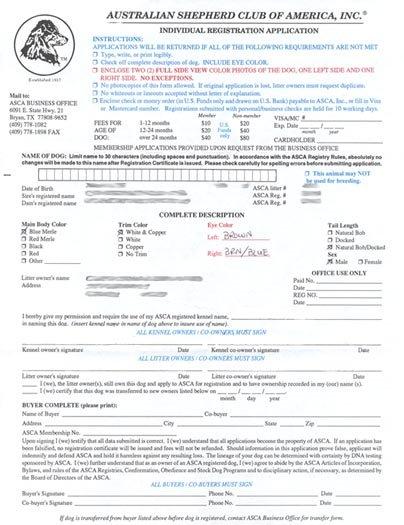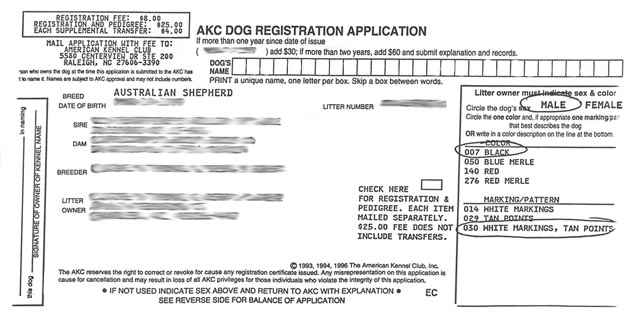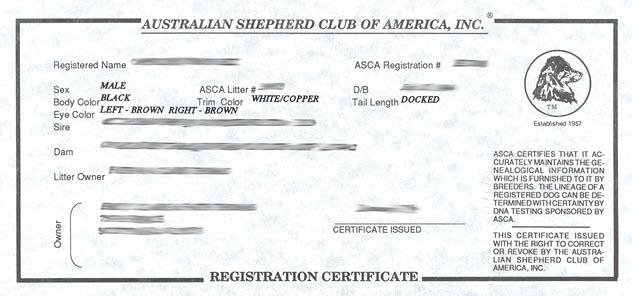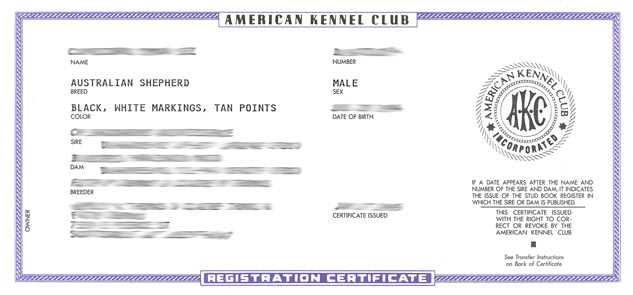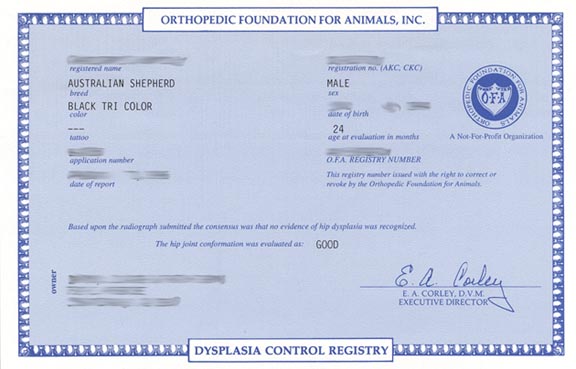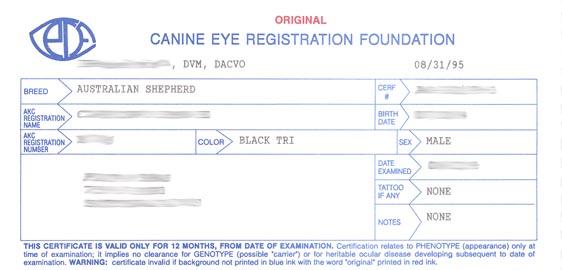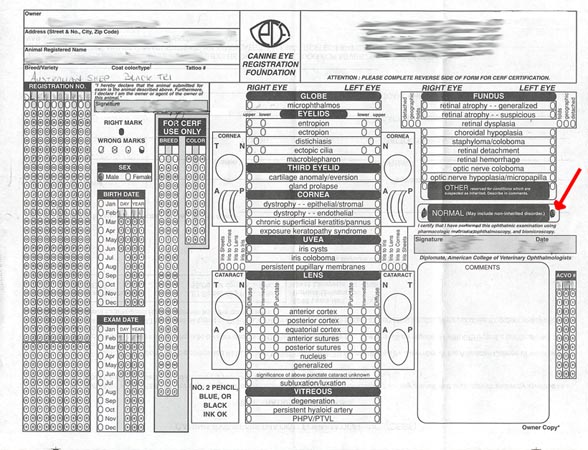BUYING AN AUSSIE PUPPY
By Kristin Rush - Shadowrun Aussies
Buying an Aussie puppy, or any puppy for that matter, can be a very emotional experience. It is all too easy to see a cute, little bundle of fluff and instantly fall in love. You might get lucky and fall into the right situation and take home a wonderful puppy, but all too often people make decisions for the wrong reasons and end up with a lot of heartache in the long run. Bringing home a new puppy is not a decision you should rush into. Be patient, do your homework, and carefully consider your options. With these things in mind, you should be able to find a wonderful lifelong companion for you and your family. It is thus the purpose of this packet to help you, the puppy buyer, to make an educated choice when acquiring your very own Aussie puppy.
ORIGIN OF THE AUSTRALIAN SHEPHERD
While there are several theories as to the specific origin of the Australian Shepherd, the one most commonly accepted is that, despite its name, the Australian Shepherd was developed predominately within the United States. In the late 1800's and early 1900's the forerunners of today's 'Aussie' came to the western and northwestern states as stockdogs with the Basque shepherds that accompanied the vast numbers of sheep then being imported from Australia. These hard working, medium-sized, 'little blue dogs' impressed the American ranchers and farmers, who admired them for their herding instinct, superior intelligence, and intense devotion to their masters. Breeding was done for working ability rather than appearance, and occasionally dogs of other herding breeds were bred into the lines, thus creating the 'Aussie' that we know today. The Australian Shepherd Club of America (ASCA) was formed in Tucson, Arizona in 1957 by a small group of Aussie fanciers who wanted to recognize and promote the breed. Initially, the International English Shepherd Registry (IESR) handled the actual registration process of the Australian Shepherd, while, in 1971, ASCA began operating as the official registry for the breed. During these early beginnings, ASCA established programs for Aussies to earn conformation, obedience, and tracking titles. A stockdog program was introduced in 1974 to preserve and promote the natural herding instinct of the breed. And, most recently, ASCA added an agility program for Aussies to earn numerous titles at several different levels of difficulty. During the 1980's, the ASCA general membership defeated several attempts to seek AKC recognition. Eventually, in 1991, an independent group of Aussie fanciers formed a new Aussie club called the United States Australian Shepherd Association (USASA) solely for the purpose of seeking AKC recognition and is today recognized by AKC as the parent club of the Australian Shepherd.
WHY AN AUSTRALIAN SHEPHERD?
Australian Shepherds are truly versatile dogs. They are extremely intelligent animals that can go from being an agile herding dog to a precision obedience competitor all while being a wonderful family companion and protector. A very endearing quality is their extreme desire to please their owners making them fast learners and loyal friends. Aussies love children, and when raised with them become a predictable and devoted family member. They are good watchdogs with strong territorial instincts, naturally possessive and protective of their family, home, and personal items. An Aussie's unusual colors and markings make them stand out and admired wherever they go. They love to play ball and frisbee and it's hard to keep most of them out of water. They also tend to have a wonderful sense of humor that makes life with an Aussie always interesting! Aussies are the perfect breed for people who want to be 'owned by' a highly trainable, super-smart dog that can work/play 'till the cows come home'. If you have the time and commitment for an Aussie, you won't be disappointed. These special dogs deserve special owners. Their loyalty, drive, attitude, and character place them in a class by themselves!
WHY NOT AN AUSTRALIAN SHEPHERD?
Aussies aren't the perfect breed for everybody! The things that make them so wonderful for some make them the wrong choice for others. Aussies are very smart, sometimes too smart for the owner who can't or won't take the time to train them. You need to stay one step ahead of an Aussie or they can and will outwit you. Obedience training is highly recommended to teach Aussie owners how to channel the typical Aussie's energy innate desire to please into desirable behavior. Aussies learn quickly, so be prepared to keep up with them. Aussies are very active. Just because Aussies are a herding breed doesn't mean they need to tend livestock to be happy, but they do need to be actively involved in your life to make a good companion. This involvement can be in many different forms including obedience, agility, tracking, frisbee, flyball, hiking, walking, playing ball, etc. It really doesn't matter what you do with your Aussie as long as you do something with him on a regular basis. He must have some type of job or purpose so he feels that he is an important part of your life and that he has a way of releasing some of his energy. The owner who leaves an Aussie ignored in the house or backyard is looking for trouble, maybe even more trouble than with most other breeds. Barking, chewing, digging, and fence jumping are common with lonely, bored Aussies. And since Aussies love to run and jump and play, they do not make very good apartment dogs unless they have dedicated owners who are willing to make time for their Aussie. Individuals who lead a quiet, sedate lifestyle but who desire an Aussie for companionship should talk extensively with breeders or an Aussie rescue representative to find a compatible, possibly trained, mature Aussie that needs a loving home. Aussies can also be very protective of their home and family, and the breed standard specifically states that an Aussie is 'reserved with strangers.' When well socialized and given time to get to know someone, Aussies will generally warm up to and accept new acquaintances. Aussies are selective about who they want to be friends with; this is not their fault, it is their nature. So, if you are looking for a dog that will enthusiastically greet and become immediate friends with everyone it meets, an Aussie might not be the right breed for you. On the other hand, if you are considering an Aussie because of these protective and stand-off-ish characteristics, remember that you must still socialize and integrate an Aussie into your lifestyle or it may still end up as a shy, aggressive, problem dog.
AUSSIES AND CHILDREN
Australian Shepherds are generally very good with children, especially if they have been raised with them. In order for your child and puppy to have a good relationship is to teach the child, as well as the puppy, what is allowed. A child should learn not to handle the dog roughly or tease him. The parent, not the child, should be responsible for correcting the puppy if it gets too rough. And the child should be taught to respect the puppy's space by not bothering the puppy when he is eating or when he chooses to take a nap in his kennel or sleeping area. Behavior that sometimes occurs with Aussie puppies and kids (and with adults too!) is, in play, the puppy may chase and nip at the heels or pant legs of the child. Aussies do this because they are bred to 'herd something moving.' This action should not be interpreted as aggression or the pup/dog trying to harm the child. In this situation, have the child or adult stop running and tell the pup/dog 'no bite'. In any case this behavior/game should definitely not be encouraged.
MALE OR FEMALE?
Although male and female Australian Shepherds share many of the same characteristics, there are also many distinct differences between the two sexes.
The female Australian Shepherd typically stands between 18-21 inches at the top of her shoulders and will on average weigh approximately 35-50 pounds. She does not usually carry the density and length of coat as a male, and her personality will generally be more sensitive and affectionate. Unspayed females will come into season approximately every 6 months and need to be confined for three weeks during this time. If you are not planning on breeding your female, you should seriously consider spaying her to avoid this inconvenience and to prevent any unwanted breedings.
The male Australian Shepherd usually stands 20-23 inches and will weigh approximately 50-65 pounds. As with most animal species, the male Aussie is the showier of the two sexes, carrying longer hair, heavier bone, and a more masculine head. He typically has a very regal air about him. Males have a tendency to be territorial and do not always take well to having to share their space with other male canines. Again, if you are not planning on using your male for breeding purposes, you should definitely consider having him neutered to make life easier for all parties concerned.
TAIL OR NO TAIL?
No one knows for sure why Aussies don't have tails, but the most logical explanation is because many Aussies are naturally born without a tail or with only part of a tail, called a natural bob tail (NBT). In order to maintain consistency within the breed, it makes sense that since we cannot put a tail back on a tail-less dog, we have to take them off the ones that do. The tail-less look has also become a recognizable characteristic of the Aussie and somewhat of a 'signature' of the breed as well as part of the breed standard.
PET OR SHOW QUALITY?
'Pet' puppies are those which are healthy and happy but are less than perfect when compared to the breed standard. Often these imperfections are minimal and are things that the novice person would not even notice. None the less, these animals would not be likely to do well in the conformation show ring, and they should NOT be used for breeding since they will not contribute to the improvement of the breed. "Pet" quality animals are eligible to be shown in obedience, agility, and herding competitions, even if they have been spayed or neutered. It is important to remember that just because a puppy is termed a "pet", it should not have any health or temperament defects. If you have any thoughts of either showing or breeding your pup, advise the breeder. In this situation, you are going to want to buy the pup that is the closest to perfection according to the breed standard. Not every pup is a future champion, and no one can guarantee you that any puppy will grow up to be a perfect specimen of the breed. But a knowledgeable breeder can spot potential qualities and will be honest with you in evaluating their puppies as future show or breeding prospects. Note: A puppy from 'champion lines' is NOT the same as one from 'champion parents!' And just because a puppy is out of one or both 'Champion Parents' does NOT guarantee that the puppy itself is going to be a 'Champion' or even show quality for that matter! PRICE? Proper raising of a litter of healthy, happy Aussie pups takes time and effort on the part of a conscientious, informed breeder and is an expensive proposition if done properly. The breeder has invested in proper nutrition, good veterinary care, training, showing, stud fees to a top quality dog, along with a great deal of time and love in the hope of producing better specimens of the breed and quality dogs for the prospective buyer. Check the paper and talk with several breeders to get a feel for what the price range for pups is in your area. Price should be consistent with the quality of the pup, and the time and expense it has taken to raise that pup. Beware of the cheap puppy because it may not be such a bargain once you get it home. Your initial investment in a puppy is going to be next to nothing in comparison to the investment you are going to make in that puppy's future. It will cost you just as much, if not more, to care for a poorly bred pup as it will for a well bred pup. Therefore, it is wise to buy the best puppy you can afford from a conscientious breeder. But also keep in mind that the most expensive puppy may not necessarily be the best puppy either. Some backyard breeders ask high prices for Aussie pups just because of their coat and/or eye color, i.e. blue merles with blue eyes. These pups' parent may not have been hip or eye checked and those 'pretty blue eyes' might cost you a lot now and a whole lot more in the future! Buying from these 'puppy producers' will only encourage them to continue their poor breeding practices. Just beware, use your head and keep your heart in check. If you are paying top price for an Aussie pup, you should make sure you are receiving the following things: ? a pup that is eligible for both ASCA and AKC registration. ? a pup whose parents are both OFA and CERF certified. ? a pup who will have his eyes cleared at 8 weeks by an opthamologist before leaving the breeder's premises. ? a pup with one or both parents titled in some area of competition or another (e.i. conformation, obedience, working, or agility). ? a pup that comes with a written guarantee covering health, hip, eye, and bite defects.
WHERE TO BUY?
Check with local veterinarians to see if they can recommend a quality Aussie breeder. Ask other Australian Shepherd owners if they are happy with the breeder they bought their pup from and if they would give you the breeder's name and phone number. Contact the Australian Shepherd Club of America (ASCA) 1-409-778-1082 and/or the American Kennel Club (AKC) 1-900-407-PUPS for breeder referrals. Also, contact a local Australian Shepherd breed club for information on breeders and shows in your area. Try to attend at least one show and spend as much time as you can observing the different Aussies present. Notice the differences in color, size, temperament, etc. Talk to as many people as you can, and ask LOTS of questions! Find out which people have puppies for sale or who may have any planned litters. Collect cards and phone numbers and make appointments to go visit breeders that interest you. Spend some time getting to know them and their dogs better, inspect their facilities, and see any puppies or dogs that sound promising to you. When making appointments to see litters, try to avoid visiting more than one litter a day. If this is unavoidable, inform the breeder before you arrive that you are planning to see other litters that same day and request that they disinfect you and others in your party as soon as you arrive and before you leave. (See info below.) This will show conscientiousness on your part, and a breeder will very much appreciate your concern and responsibility. Be cautious of a breeder who doesn't ask if you have visited other breeders that day or who doesn't take the below precautions to prevent possible infectious disease exposure to their own litter. The typical disinfectant used is a bleach and water mixture, so prepare to smell like bleach for the rest of the day, and wear clothes that you are not worried about getting possible bleach stains on. Bleach is used because it is readily available and because it destroys certain canine viruses (in particular Parvo and Distemper). It might be a good idea for you to mix your own bleach water and carry it with you in your vehicle, which again shows conscientiousness on your part. Any manual spray bottle works well for the mixture and is be easy to use. Just mist yourself with the mixture, paying special attention to your hands and shoes, including and in particular the soles. Appropriate ratios for the mix are between 1 part bleach to 4 parts water to 1 part bleach to 10 parts water. An interesting note here is that the bylaws of the Australian Shepherd Club of America prohibit its members from selling Australian Shepherd puppies through pet stores. Therefore, Aussie pups that you see in pet shops would more than likely not be from reputable kennels or from members in good standing with the Australian Shepherd Club of America. Also, what respectable breeder would turn over the placement of his treasured puppy to a firm interested only in making a profit? Pet stores have high overhead, and these costs are passed along directly in the cost of the pups they sell. So, generally, pet store puppies will cost more and will not come from a kennel that is driven by a desire to produce a top quality specimen of the breed. Think about it!
WHAT MAKES A GOOD BREEDER?
When you eventually buy your puppy, not only will you form a bond with the pup, but you will also, more than likely, form some type of bond with the breeder you purchase your pup from. Initially you will look to this person to answer questions and offer guidance in the raising of your pup, and later you may still seek advice and support from them as your dog matures and gets older. It is therefore important that you feel comfortable with this person and have a good working relationship with them. The main things to look for in a breeder are reputation, quality, and commitment. Get references from breeders you are considering buying a puppy from. These references should include other Aussie breeders as well as previous puppy buyers. Ask around randomly about the breeder's reputation as well. Remember, not everyone agrees with everything everyone else does and there will always be someone who has something negative to say about even the most pristine breeder, so take these comments with a grain of salt. But when you hear the same criticisms repeated over and over by several different sources, then you should be concerned. Just because a person raises one or two litters a year and sells pups regularly, does not make them a good breeder! Puppies produced by 'backyard breeders' are frequently of poor quality, have health and genetic faults, and can give you a lot more trouble than you bargained for. Again, purchasing pups from these types of breeders only encourages them to carelessly continue to produce and sell more and more puppies without regard for what they are doing to the breed. On the other hand, a conscientious breeder works extremely hard to improve the quality of the breed. Each litter is carefully planned to combine the qualities of the sire and dam to hopefully produce even better dogs. Good breeders make a significant investment in both time and money in planning and producing a litter since they have a strong desire to create an outstanding dog and because of their genuine love for the breed. They can also discuss the pros and cons of the breed and are knowledgeable about history, care, maintenance, training, etc. And a good breeder will not hesitate to tell you that an Australian Shepherd may not be the right dog for you if they feel that Aussie ownership would not be in your best interest. Remember their goal is not to sell you a dog but rather to find the perfect home for one of their treasured puppies.
WHAT TO ASK?
The following is a list of questions to take with you when you visit each breeder and litter. Do not feel embarrassed asking all these questions; a responsible breeder will welcome your interest and will admire your knowledge and concern for the breed.
1. Ask for a pedigree on the puppies. This should include at least 3 generations of ancestry, preferably 4 to 5 generations. Make sure you get a copy you can take home with you so that you can review it later in more detail. Again remember, a pedigree full of champions does not always guarantee a future champion. And vice versa, many top winning dogs have come from non-champion sires and dams.
2. Was the breeding planned or unplanned?
3. If the litter was planned, ask why the sire was chosen for this particular dam? Was it a matter of convenience because they own the sire or was it because they felt the qualities of the sire would compliment or even improve the qualities of the dam?
4. What are the faults of both the sire and dam? A conscientious breeder should be both knowledgeable and willing to talk about their dog's faults as well as about their dog's assets. Remember, there are no perfect dogs.
5. What was the goal of the breeding? For profit? To produce the ultimate show/working dog? So the kids could experience the miracle of birth?
6. What area does the breeder feel these pups will excel in? Obedience, working, agility, show, family pet?
7. What kind of support services will the breeder offer you to help you attain your goals for your puppy? If for conformation showing, obedience, agility, or working is the breeder willing to spend some time with you helping you to get started in these areas, and will the breeder be there if you have any questions or problems regarding housebreaking, digging, barking, etc.? As mentioned earlier, an important benefit of buying a purebred dog from a breeder is the continuing relationship you will have with the breeder. Therefore, you should feel comfortable and confident with the person from whom you are buying your puppy and with whom you are going to form this relationship. The breeder should also remain in contact with you to periodically check on the puppy and your progress together.
8. Are both the sire and dam OFA or PennHIP certified? And, if so, what are their numbers and ratings? (OFA stands for the Orthopedic Foundation for Animals; PennHIP stands for Pennsylvania Hip Improvement Program. Both organizations evaluate and certify hip joint conformation.) Only Aussies that are free from hip dysplasia are granted OFA or PennHIP numbers. Be wary of any breeder who does not know what OFA or PennHIP stands for or who cannot provide you with copies of both parents' certificates. Do not let anyone tell you that they know their dog is not dysplastic because of the way it runs or lays down, etc. Or that their dogs have never had any hip problems, so therefore they don't bother with x-rays and certification. If they don't check for the disease, how will they ever know if their dogs are affected or not? The fact is that any breed of dog that weighs over 30 pounds is prone to Canine Hip Dysplasia. Dysplasia is a hereditary defect, so if you are not sure about the parents' hip status, then what about that cute little puppy you are about to take home? (For an example of an OFA certificate see Item A.)
9. Have both the sire and dam had a current eye examination? An organization called CERF (Canine Eye Registry Foundation) deals with the certification of eyes just as OFA does for the hips. Some breeders will send the results of their dog's eye exam in to CERF for an official certificate (Item B); while other breeders may just use the eye exam form signed by a qualified veterinarian (Items C). Be sure to look at the exam report carefully to see that it matches with the correct Sire or Dam and that the vet has made a notation that the eyes are clear from any visible defects. Eye exams are normally done on an annual basis, so also check to see that the exam is current (within the last year). Again, eye defects (cataracts, PRA, collie eye anomaly) are hereditary, so the best way to make sure your new puppy will not be affected with any of these problems is to verify that the parents are free from any problems themselves.
10. What type of guarantee does the breeder offer if the puppy is later found to be affected with any hereditary defect? Breeding only dogs that have been cleared free of any defects will greatly reduce the possibility of reproducing puppies with congenital defects; however, genetic throwbacks do occur. Some breeders offer different alternatives if you happen to have a puppy who ends up with a hereditary problem. These alternatives will vary depending on the breeder and depending on whether the puppy is bought as either pet or show quality.
11. Is the puppy's health guaranteed? Some breeders will give a 2-7 day health guarantee; however, if the breeder does not offer this, ask if you can return the puppy within 24 hours, for a full refund, if the puppy does not pass a health examination given by your vet. Health guarantees do not absolutely guarantee that you will get a pup without any health or genetic problems, but it does mean that the breeder is trying to breed healthy dogs and is willing to stand behind the pups that they produce.
12. Will a written contract be provided to cover the above issues? If offered, ask to read the contract before purchasing the puppy to see if it covers all the breeder's stated guarantees.
13. Can you meet the parent(s) of the puppy and other dogs owned and/or bred by the breeder? Temperament is very important and meeting relatives of the puppies is the best way to see what kind of disposition these pups might inherit. It is best to meet Mom away from her litter since she may be very protective of them, which is natural and should not be held against her. Also, remember she has just spent the last 8 weeks feeding and caring for quite a few young ones, so if she doesn't look quite as good as the other dogs in the household, it's understandable.
14. Why do you breed dogs? There is no right answer to this question, but it should provide you some more insight into the person with whom you are dealing.
QUESTIONS YOU SHOULD EXPECT TO BE ASKED OF YOU
A responsible breeder will more than likely have a list of questions for you as well. Expect to be asked why it is you want an Aussie; what you expect from a dog; what type of activities you enjoy; what type of yard you have (what type of fence and how high it is); if the dog will be allowed in the house as a member of your family; if you have any other pets; what will you do with the dog when you go on vacation; if you have had another dog; and, if so, how old was he when he passed away, and how? Aussies are not a breed for everyone, and a responsible breeder will want to screen you to make sure you understand an Aussie's characteristics and activity levels, and that an Aussie is well suited to your lifestyle and expectations. They will also want to make sure their pup is going to a loving, caring, responsible home and, that once their pup is placed in your home, he is going to be there for the rest of his life. A good breeder owes both the buyer and their animals careful and thoughtful consideration when it comes to placement of their pups. Their concern will ultimately benefit you in the long run. Be wary of the breeder who doesn't ask any questions and is willing to sell you any puppy right off the bat just because you can produce their asking price.
REGISTRATION PAPERS
If your new pup is sold with registration papers, make sure the papers you receive are from the correct registry for your purposes. ASCA stands for Australian Shepherd Club of America and is the parent registry for the Australian Shepherd, founded in 1957. ASCA keeps stud books on all registered Aussies; registers purebred Australian Shepherd pups and adults; sanctions conformation, obedience, and agility shows; and has a working trial program that allows Aussies to earn herding titles. A dog that is registered only with ASCA is not eligible to compete at AKC events for AKC titles. AKC stands for the American Kennel Club. As with ASCA, AKC registers purebred Aussies, sanctions conformation, obedience, and agility shows, and has a herding program for herding breeds to earn working titles. AKC only recognizes titles earned through the AKC program, and if a dog is only registered with AKC, it can not compete in ASCA conformation shows for ASCA titles. IESR stands for International English Shepherd Registry and is also referred to as NSD, the National Stockdog Registry. This registry is not active in sanctioning events; and is basically just a paper registry. Aussies registered only with this registry, even though they may be a purebred Australian Shepherd, are not allowed to compete in ASCA or AKC sanctioned events for ASCA or AKC title. An Australian Shepherd may be registered with any or all of these registries; this is where the term double or triple registered comes from. Check with the breeder to find out which registry their pups are eligible for, and ask to see the registration application(s) if you have any doubts. If you have no intentions of showing or breeding your puppy, then the registry your pup is eligible for is not as pertinent. If you do intend to show or breed, your pup should be registered with ASCA and AKC.
MAKING YOUR DECISION
Make a point to look at several litters before making your final decision. Take note of the conditions the adults and pups are being raised in; is their environment clean, is there adequate room for exercise, plenty of shade and shelter, etc.? Do the older dogs appear to be happy and well cared for? Do they seem to be well mannered and not fearful or aggressive? The pups should be outgoing and eager to play. They should come to you willingly and should not recoil in fear or run if you go to pick one up. The puppies should look well fed, their coats should be clean and healthy, their gums should be pink, their eyes should be clear of any discharge, the inside of the ears should not be red or inflamed, and the pups in general should have a healthy, happy attitude. Spend some time playing with the puppies and get a feel for their different personalities. Ask the breeder for further background on puppies that catch your eye; sometimes a pup may have a slightly different character than the one he displays while you are visiting. A concerned breeder will be honest and candid in discussing each puppy with you since their goal is to find the pup that will most likely match your lifestyle and fulfill your expectations. Try not to get too concerned with choosing a puppy based solely on it's sex, color, or markings. It would be a shame to pass up a plain colored black tri male who just adores you and keeps bringing you his toys to play with for a blue merle female with a full white collar who always hangs back and does not want to interact with you or any member of your family. If you are trying to decide between two or three pups that all seem to be vying for your attention, then let color and markings come into the picture. But otherwise, let personality be your key deciding factor. Amazingly enough, an Aussie pup will generally pick you in some way or another. Sometimes these signs are subtle and sometimes they are very obvious, but either way, watch for them because the best matches result when a pup decides he would like you to belong to him!!! After leaving each breeder's facilities, make notes on the puppies you liked and on your general impressions. Do this with each litter you visit. Then, when you feel like you have a good basis of comparison, sit down and go over your notes. Call back with any additional questions you might have. Before you make your final decision, go back and visit the pups that are the highest on your consideration list. You may find that pups behave slightly differently each time you see them depending on the time of the day you visit, if they have just eaten, if they have just awoken from a nap, or if they have just been playing for the last 30 minutes prior to your arrival, etc. There is no absolute right or wrong way to go about selecting the right dog for you. Emotions are still going to play a big part in your decision, but hopefully the previous information will give you a basis for making an educated decision as well.
GOOD LUCK!
THINGS YOU SHOULD RECEIVE WITH YOUR NEW PUPPY
When you make your final selection, make sure the following items are in order before you pay for your new puppy.
1. An individual registration application for ASCA and/or AKC (Items A & B),
Item A - This is a sample of an ASCA Registration Application (You should receive the original copy)
Item B - an AKC Registration Application (This is a xerox, you should receive the colored original copy) or a registration certificate(s) (Item C or D),
Item C - This is a sample of an ASCA Individual Registration Certificate (the original copy)
Item D - an AKC Individual Registration Certificate (the original copy)
or a written agreement stating the reason for not giving any registration privileges.
2. A written sales agreement outlining all terms and conditions which the buyer and seller have previously agreed upon.
3. A minimum of a three generation pedigree.
4. A photocopy of the OFA Rating Certificate of both the sire and the dam (Item E).
Item E - This is a sample of an OFA Certificate (the original copy)
5. A photocopy of either the CERF Certificate or the veterinary eye exam papers of both the sire and the dam (Item F or G).
Item F - This is a sample of a CERF Certificate (the original copy)
Item F - This is a sample of CERF Exam Papers (Note the red arrow, which points to bubbles that have been filled in to indicate a "normal" examination)
6. A schedule of dates and types of vaccines, wormings, and any other treatments the puppy has received, as well as a recommended schedule for further vaccinations and wormings.
7. A feeding schedule and enough of the puppy's regular food to last at least 48 hours, as well as recommendations on what types of food to feed.
8. Any reading material on the breed or puppy care that the breeder may have to offer.
9. An item that holds a familiar scent from home. (A piece of bedding or an old toy.) You may even want to bring your own towel or bedding over to the breeder's a week or so before you pick your pup up. Ask the breeder to throw it in with the other bedding and then bring it home with you and your new pup.
